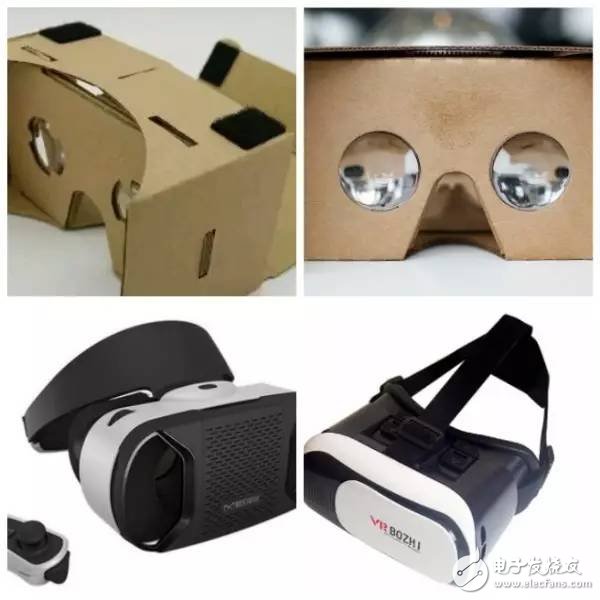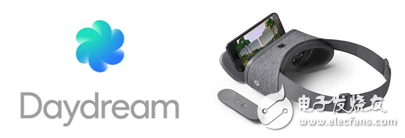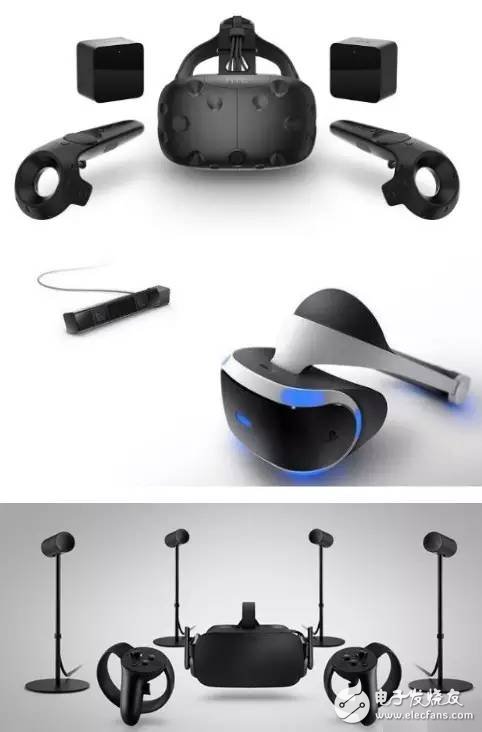Research on Space Monitoring and Positioning Technology of ARVR Equipment
All ARVR (Augmented Reality and Virtual Reality) products must have accurate space monitoring and positioning capabilities to enable a full range of head and hand interactions, thus delivering a more immersive and realistic virtual experience.
First, the current status of ARVR products: There are numerous ARVR products available on the market, with price ranges varying from affordable options like Google Cardboard (priced in the tens of dollars) to high-end devices such as Microsoft HoloLens (costing thousands). VR products can be broadly categorized into several types. 1. Cardboard Products Cardboard-style VR devices are among the most basic forms of VR. They originated from Google's cardboard VR headset, which uses two convex lenses to project mobile phone screen content onto the glasses. The user’s head movements are tracked using the built-in IMU (Inertial Measurement Unit) in the phone, adjusting the VR display accordingly. These devices became popular in China around 2015, but their performance heavily depends on the phone's specifications and lens quality, making them an entry-level option.
Some early VR products from domestic video and game companies were based on this design. The Storm Box, for example, included a Bluetooth controller for menu navigation. While these devices helped promote the VR industry, they had significant limitations, leading to the rise of integrated systems like the Storm Machine, Big Friends, and Small Birds in 2016.
In 2016, Google introduced Daydream VR, aiming to dominate the VR ecosystem. It required a compatible smartphone, such as the Pixel or Pixel XL, paired with a Daydream Viewer and a remote control handle with an IMU. This setup aimed to provide a smoother and more comfortable VR experience, especially with the release of smartphones like Huawei P9 and Lenovo MotoZ that supported Daydream.
2. Head-Motion-Controlled Integrated Machines
Cardboard-style VR devices are among the most basic forms of VR. They originated from Google's cardboard VR headset, which uses two convex lenses to project mobile phone screen content onto the glasses. The user’s head movements are tracked using the built-in IMU (Inertial Measurement Unit) in the phone, adjusting the VR display accordingly. These devices became popular in China around 2015, but their performance heavily depends on the phone's specifications and lens quality, making them an entry-level option.
Some early VR products from domestic video and game companies were based on this design. The Storm Box, for example, included a Bluetooth controller for menu navigation. While these devices helped promote the VR industry, they had significant limitations, leading to the rise of integrated systems like the Storm Machine, Big Friends, and Small Birds in 2016.
In 2016, Google introduced Daydream VR, aiming to dominate the VR ecosystem. It required a compatible smartphone, such as the Pixel or Pixel XL, paired with a Daydream Viewer and a remote control handle with an IMU. This setup aimed to provide a smoother and more comfortable VR experience, especially with the release of smartphones like Huawei P9 and Lenovo MotoZ that supported Daydream.
2. Head-Motion-Controlled Integrated Machines
 These all-in-one devices do not require a phone or PC. Examples include Big Friends and Small Birds, which were released in 2016. They feature high-resolution displays (1080p or 2K) and specialized Fresnel aspherical lenses for better visual quality. However, they typically only support head movement tracking, allowing users to look around while standing or sitting. To enhance interaction, external accessories like IMU-equipped controllers or motion-tracking backpacks are often used.
3. All-in-One with Spatial Tracking
These all-in-one devices do not require a phone or PC. Examples include Big Friends and Small Birds, which were released in 2016. They feature high-resolution displays (1080p or 2K) and specialized Fresnel aspherical lenses for better visual quality. However, they typically only support head movement tracking, allowing users to look around while standing or sitting. To enhance interaction, external accessories like IMU-equipped controllers or motion-tracking backpacks are often used.
3. All-in-One with Spatial Tracking
 There are two main methods for spatial tracking: Inside-out and Outside-in. Inside-out uses sensors built into the device to track its position, while Outside-in relies on external sensors. Most all-in-one devices use Inside-out technology, offering greater convenience by eliminating the need for extra hardware. Some upcoming models, like the second-generation Big Friends and Storm Machine, are expected to integrate spatial tracking, significantly enhancing the VR experience, particularly in gaming.
4. PC-Based VR
There are two main methods for spatial tracking: Inside-out and Outside-in. Inside-out uses sensors built into the device to track its position, while Outside-in relies on external sensors. Most all-in-one devices use Inside-out technology, offering greater convenience by eliminating the need for extra hardware. Some upcoming models, like the second-generation Big Friends and Storm Machine, are expected to integrate spatial tracking, significantly enhancing the VR experience, particularly in gaming.
4. PC-Based VR
 The most well-known PC-based VR systems are HTC Vive, Sony PSVR, and Oculus Rift. These devices use external spatial tracking technologies. For example, Vive employs infrared laser transmitters, while PSVR and Oculus use external sensors to detect light from the head-mounted display and controllers. This allows precise tracking of both the head and hand movements, creating a more realistic VR environment.
Next, let's discuss AR products. Currently, AR devices vary greatly in functionality. Some only project virtual images without integrating with the real environment. For instance, ODG supports 6DOF (six degrees of freedom) motion tracking but lacks spatial positioning. Shanghai Zhishi's smart glasses also lack spatial tracking, though they are developing a version with TOF depth cameras for 6DOF + spatial tracking.
Among current AR products, the best spatial tracking is found in Lenovo Phab2 Pro (based on Google Tango) and Microsoft HoloLens. Both combine 6DOF + SLAM (Simultaneous Localization and Mapping), enabling virtual objects to merge seamlessly with the real world. HoloLens is generally considered more accurate and stable than Tango due to its advanced hardware and software design.
Other Chinese companies, like Micro Eye, are also developing AR devices similar to HoloLens, with comparable 6DOF + SLAM performance.
Second, the spatial positioning technology categories:
Space monitoring and positioning technology is broadly divided into two types: Inside-out and Outside-in.
1. Inside-Out Spatial Monitoring and Positioning Technology
Inside-out technology works by sensing the environment from within the device, much like how humans perceive surroundings through vision. It is commonly used in AR devices. One major approach is SLAM (Simultaneous Localization and Mapping), which enables the device to map its environment and locate itself in real time.
Lenovo Phab2 Pro and HoloLens are examples of SLAM-based systems. Both use depth cameras and Fisheye lenses for motion tracking. HoloLens, however, offers better accuracy and stability, especially in low-light conditions. Tango, on the other hand, is continuously improving with features like multiple Fisheye cameras in future versions.
Another type of inside-out system uses markers—such as QR codes, special colors, or light spots—placed in the environment. These serve as reference points for the device to determine its position. HTC Vive is a prime example of this method, using infrared lasers and sensors to track the head and controllers.
2. Outside-In Spatial Monitoring and Positioning Technology
Outside-in technology is more mature and widely used in VR systems like Sony PSVR and Oculus. These systems rely on external cameras or sensors to track the user’s position. For example, PSVR uses a dual-camera system to monitor light from the head and controllers, while Oculus uses infrared signals for tracking.
One limitation of outside-in systems is that they may miss tracking when the user moves out of the camera’s view. However, companies like Ximmerse have developed alternative solutions, such as using light balls and dual cameras placed in fixed positions to track the user’s movements.
In summary, both Inside-out and Outside-in technologies have their strengths and weaknesses. The choice between them depends on factors like mobility, accuracy, and ease of use. As ARVR continues to evolve, we can expect even more advanced spatial tracking solutions in the future.
The most well-known PC-based VR systems are HTC Vive, Sony PSVR, and Oculus Rift. These devices use external spatial tracking technologies. For example, Vive employs infrared laser transmitters, while PSVR and Oculus use external sensors to detect light from the head-mounted display and controllers. This allows precise tracking of both the head and hand movements, creating a more realistic VR environment.
Next, let's discuss AR products. Currently, AR devices vary greatly in functionality. Some only project virtual images without integrating with the real environment. For instance, ODG supports 6DOF (six degrees of freedom) motion tracking but lacks spatial positioning. Shanghai Zhishi's smart glasses also lack spatial tracking, though they are developing a version with TOF depth cameras for 6DOF + spatial tracking.
Among current AR products, the best spatial tracking is found in Lenovo Phab2 Pro (based on Google Tango) and Microsoft HoloLens. Both combine 6DOF + SLAM (Simultaneous Localization and Mapping), enabling virtual objects to merge seamlessly with the real world. HoloLens is generally considered more accurate and stable than Tango due to its advanced hardware and software design.
Other Chinese companies, like Micro Eye, are also developing AR devices similar to HoloLens, with comparable 6DOF + SLAM performance.
Second, the spatial positioning technology categories:
Space monitoring and positioning technology is broadly divided into two types: Inside-out and Outside-in.
1. Inside-Out Spatial Monitoring and Positioning Technology
Inside-out technology works by sensing the environment from within the device, much like how humans perceive surroundings through vision. It is commonly used in AR devices. One major approach is SLAM (Simultaneous Localization and Mapping), which enables the device to map its environment and locate itself in real time.
Lenovo Phab2 Pro and HoloLens are examples of SLAM-based systems. Both use depth cameras and Fisheye lenses for motion tracking. HoloLens, however, offers better accuracy and stability, especially in low-light conditions. Tango, on the other hand, is continuously improving with features like multiple Fisheye cameras in future versions.
Another type of inside-out system uses markers—such as QR codes, special colors, or light spots—placed in the environment. These serve as reference points for the device to determine its position. HTC Vive is a prime example of this method, using infrared lasers and sensors to track the head and controllers.
2. Outside-In Spatial Monitoring and Positioning Technology
Outside-in technology is more mature and widely used in VR systems like Sony PSVR and Oculus. These systems rely on external cameras or sensors to track the user’s position. For example, PSVR uses a dual-camera system to monitor light from the head and controllers, while Oculus uses infrared signals for tracking.
One limitation of outside-in systems is that they may miss tracking when the user moves out of the camera’s view. However, companies like Ximmerse have developed alternative solutions, such as using light balls and dual cameras placed in fixed positions to track the user’s movements.
In summary, both Inside-out and Outside-in technologies have their strengths and weaknesses. The choice between them depends on factors like mobility, accuracy, and ease of use. As ARVR continues to evolve, we can expect even more advanced spatial tracking solutions in the future.The Power Wall Battery is a high-performance home battery solution from Keylewatt. The following is a detailed description of its class purpose:
I. Product overview
Keylewatt, Powerwall is a Battery Energy Storage System designed for the home, designed to provide a reliable reserve of electricity for the home by storing electricity generated by solar panels or electricity from the grid. Not only can it provide power at night or when the weather is bad, it can also serve as a backup power source to ensure that the home power supply is not affected in the event of a power outage.
Two, the main characteristics
High energy storage density:
The Powerwall is capable of storing large amounts of electricity in a small design to meet the daily electricity needs of the home.
Advanced Battery technology:
Advanced battery technology for longer life and higher efficiency.
From the first generation to the third generation, the battery technology of the Powerwall has been continuously upgraded, such as the use of 21700 cells, integrated solar inverters, etc., to further improve the overall performance of the system.
Intelligent control function:
The Powerwall is equipped with an intelligent control system that automatically monitors the status of the battery and charges and discharges it as needed.
Users can remotely monitor and manage the working status of the Powerwall through a mobile app or web interface.
Multiple application scenarios:
The Powerwall is not only suitable for home use, but also for commercial and industrial applications.
At peak times, the Powerwall can release stored electricity and reduce the load on the grid.
At the same time, it can also be used as a charging pile for Tesla vehicles to provide charging services for electric vehicles.
Environmental protection and Sustainable development:
By storing electricity generated from renewable sources such as solar, Powerwall reduces reliance on traditional energy sources, helping to lower carbon emissions and protect the environment.
It promotes the energy transition and the development of renewable energy, in line with the concept of sustainable development.
Power storage battery system, solar system with power battery, commercial and industrial system
Foshan Keylewatt Technology Co., LTD , https://www.klwenergy.com